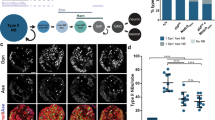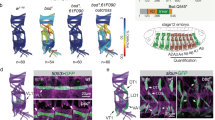Abstract
Pattern formation in the Drosophila embryo requires the concerted expression of maternal and zygotic genes. At least nineteen genes, twelve of which are maternally expressed, are involved in the establishment of dorsal–ventral polarity1—4. Mutations in any one of these genes result in distinct alterations of cell fates and in the formation of an abnormal dorsal–ventral pattern1. Mutants of the 'dorsal group', eleven of the maternal genes, have a common recessive phenotype similar to that described for dorsal, in that cells located at ventral and lateral positions assume dorsal fates and ventral structures fail to develop. Thus the dorsal group gene products may be involved in the establishment of a gradient of positional information along the dorsal–ventral axis1,3. We have cloned snail (sna), a zygotic gene, whose expression is essential for the correct specification of dorsal–ventral pattern. In this report, we present evidence that the complementary DNA-deduced protein product of sna contains five copies of a nucleic acid-binding finger motif previously identified in two transcription factors5,6, and in the protein product of several putative regulatory genes7—11.
This is a preview of subscription content, access via your institution
Access options
Subscribe to this journal
Receive 51 print issues and online access
$199.00 per year
only $3.90 per issue
Buy this article
- Purchase on Springer Link
- Instant access to full article PDF
Prices may be subject to local taxes which are calculated during checkout
Similar content being viewed by others
References
1. Niisslein-Volhard, C. in Determination of Spatial Organisation (eds Subtelmy, S. & Konigsberg, I.) 185-211 (Academic, New York, 1979). 2. Anderson, K. V. & Niisslein-Volhard, C. in Pattern Formation (eds Malacinski, G. M. & Bryant, S.) 269-289 (Macmillan, New York, 1984). 3. Anderson, K. V. Trends Genet. 3, 91-97 (1987). 4. Grau, Y., Carteret, C. & Simpson, P. Genetics 108, 347-360 (1984). 5. Miller, J., McLachlan, A. D. & Klug, A. EMBO J. 4, 1609-1614 (1985). 6. Hartshorne, T. A., Blumberg, H. & Young, E. T. Nature 320, 283-287 (1986). 7. Vincent, A., Colot, H. V. & Rosbash, M. /. molec. Biol. 186, 149-166 (1985). 8. Rosenberg, U. B. et al. Nature 319, 336-339 (1986). 9. Schuh, R. et al. Cell 47, 1025-1032 (1986). 10. Tautz, D. et al. Nature 327, 383-389 (1987). 11. Chowdhury, K., Deutsch, U. & Gruss, P. Cell 48, 771-778 (1987). 12. Ashburner, M., Tsubota, S. & Woodruff, R. C. Genetics 102, 401-420 (1982). 13. Chia, W., Karp, R., McGill, S. & Ashburner, M. /. molec. Biol. 186, 689-706 (1985). 14. Poole, S. J., Kauvar, L. M., Drees, B. & Kornberg, T. Cell 40, 37-43 (1985). 15. Rosenberg, U. B., Preiss, A., Seifert, E., Jackle, H. & Knipple, D. C. Nature 313, 703-706 (1985). 16. Cabrera, C. V., Alonso, M. C., Johnston, P., Phillips, R. G. & Lawrence, P. A. Cell 50, 659-663 (1987). 17. Weintraub, H., Izant, J. G. & Harland, R. M. Trends Genet. 1, 22-25 (1985). 18. Cavener, D. R. Nucleic Acids Res. 15, 1353-1361 (1987). 19. Marshall, R. D. A. Rev. Biochem. 41, 673-702 (1972). 20. Patschinsky, T., Hunter, T., Esch, F. S., Cooper, J. A. & Sefton, B. M. Proc. natn. Acad. Sci. U.S.A. 79, 973-977 (1982). 21. Berg, J. M. Nature 319, 264-265 (1986). 22. Berg, J. M. Science 232, 485-487 (1986). 23. Green, S. & Chambon, P. Nature 324, 615-617 (1986). 24. Thisse, B., El Messal, M. & Perrin-Schmitt, F. Nucleic Acids Res. 15, 3439-3453 (1987). 25. Maniatis, T., Fritsch, E. F. & Sambrook, J. Molecular Cloning, a Laboratory Manual (Cold Spring Harbor Laboratory, New York, 1982). 26. Simpson, P. Genetics 105, 615-632 (1983). 27. Sanger, F., Nicklen, N. S. & Coulson, A. R. Proc. natn. Acad. Sci. U.S.A. 74,5463-5467 (1977). 28. Lin, H. C., Lei, S. P. & Wilcox, G. Analyt. Biochem. 147, 114-119 (1985).
Author information
Authors and Affiliations
Rights and permissions
About this article
Cite this article
Boulay, J., Dennefeld, C. & Alberga, A. The Drosophila developmental gene snail encodes a protein with nucleic acid binding fingers. Nature 330, 395–398 (1987). https://doi.org/10.1038/330395a0
Received:
Accepted:
Issue Date:
DOI: https://doi.org/10.1038/330395a0
This article is cited by
-
Expression of epithelial-Mesenchymal transition related markers in Plasmacytoid Urothelial carcinoma of the urinary bladder
BMC Urology (2020)
-
Guidelines and definitions for research on epithelial–mesenchymal transition
Nature Reviews Molecular Cell Biology (2020)
-
SRPX2 Enhances the Epithelial–Mesenchymal Transition and Temozolomide Resistance in Glioblastoma Cells
Cellular and Molecular Neurobiology (2016)
-
Combined silencing of TGF-β2 and Snail genes inhibit epithelial-mesenchymal transition of retinal pigment epithelial cells under hypoxia
Graefe's Archive for Clinical and Experimental Ophthalmology (2015)
-
Central role of Snail1 in the regulation of EMT and resistance in cancer: a target for therapeutic intervention
Journal of Experimental & Clinical Cancer Research (2014)
Comments
By submitting a comment you agree to abide by our Terms and Community Guidelines. If you find something abusive or that does not comply with our terms or guidelines please flag it as inappropriate.



